-
Contact
Sales & Customer Service
0800 612 6537 support@safelincs.co.uk Live ChatDelivery Enquiries
0800 077 6149 - Resources
Fire & Safety Solutions
CALL OUR TEAM NOW 0800 612 6537
Lines open today 8:30am - 5pm
Free Delivery
on 100s of Products
Secure Payments
with our fast checkout
Live Customer Chat
Available Now
30 Day Accounts
for Public Sector
5 Star Customer Feedback
Defibrillator Buying Guide
Which defibrillator should I buy?
Choosing an AED (Automatic External Defibrillator) can be daunting. Here we explain the key differences between each type of AED and what features to look out for to help you make your decision.
You may also find the following articles useful:
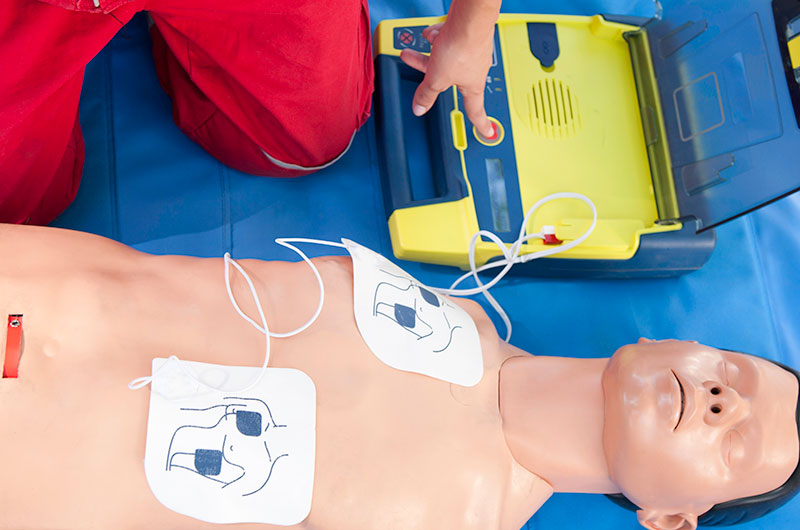
Fully automatic vs semi-automatic defibs
A fully automatic defibrillator is ideal for use by untrained individuals and the general public. It delivers the shock to the heart automatically without any need for intervention.
A semi-automatic defibrillator requires a bit more input from the user and is therefore better suited to someone who has had training or healthcare professionals and first responders. It calculates when the shock needs to be delivered and will prompt the user to press a button to administer it.
Both types of defibrillators have clear step-by-step voice and/or visual prompts that walk users through the rescue process. All defibrillators are portable so that they can be moved to the location of the casualty.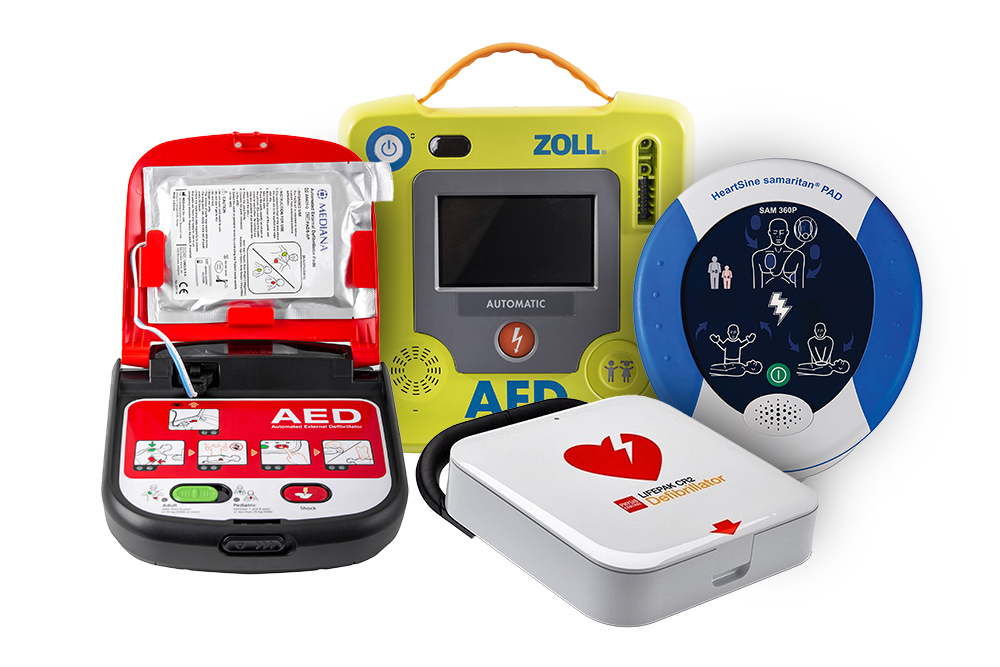
Key AED features
Warranty – Manufacturer’s warranty for AEDs range from 1 year to 10 years.
Battery life – Defibrillator batteries have a ‘shelf life’ and a ‘standby life’. Standby life refers to the length of time that a battery will provide charge to a defibrillator once it is installed. Shelf life refers to the time that the battery can be stored (according to the manufacturer’s instructions) before it is installed. A lower stand-by battery life will mean more replacement AED batteries will need to be purchased during the lifetime of the defibrillator. Battery life varies from 4 years to 7 years.
Pad life – Defibrillator pads, like batteries, have a ‘shelf life’ and a ‘standby life’ The lifetime of the electrode pads ranges from 1.5 years to 5 years after which time replacement AED pads will need to be purchased.
IP rating – The IP rating tells you how weatherproof, waterproof and dustproof the defibrillator is. If your AED is likely to be used outside in all weather or in dusty environments, consider an IP56 rated AED which gives the best protection.
Carry case – Some defibrillators come with a carry case. This may be useful if you are planning to transport your AED to different locations, for example for a sporting event like Parkrun. Choose between a soft case or a hard carry case depending on the level of protection your AED requires. You can also purchase a defibrillator carry case separately if yours does not have one.
Adult/child suitable – All AEDs are suitable for adults. Some defibrillators are suitable for children and infants over one year. The level of power required to restore a child’s heartbeat is less than that of an adult heartbeat. Some AEDs are available with adult pads or child pads which regulate the power level. Other defibrillators can be switched between child or adult modes so only one set of pads will need to be replaced.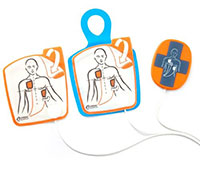
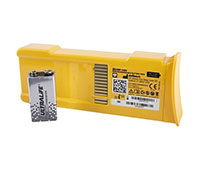
- View our defibrillator overview table to compare defibrillators and their features
How to store a defibrillator
Defibrillators should be visible and accessible so that they can be easily located and deployed in an emergency.
Indoor vs outdoor defibrillator cabinets
If you plan to store your AED inside a building where the temperature does not drop below 8°C, you can choose between a wall bracket or an indoor cabinet. An outdoor cabinet should always be used if you plan to store your AED outside or anywhere where the temperature will drop below 8°C.
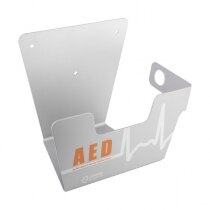
A wall bracket can be wall mounted in a visible and accessible location that is easy for everyone to find in an emergency. They are easy to install and come complete with screw fixings. Most wall brackets have been designed to fit a specific model of AED. So, if you wish to use a bracket to wall mount your defibrillator, check that there is one suitable for the make or model.
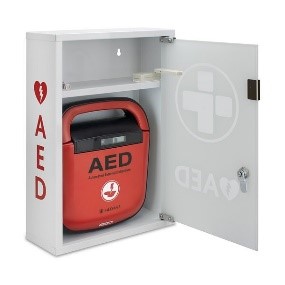
Indoor defibrillator cabinets provide more protection for your AED than a wall bracket. They can guard against misuse and will protect against knocks or damage. The indoor cabinets are easily accessible and provide an obvious location for the device. Indoor cabinets can be wall-mounted using the fixings provided.
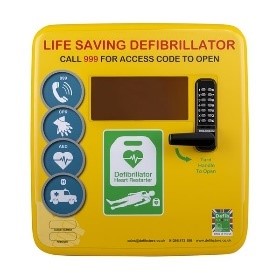
Outdoor defibrillator cabinets provide maximum protection for your AED. They are usually brightly coloured so they can be easily identified. The cabinets have high IP ratings, meaning that they will not allow dust or water to damage the AED. They are made from durable materials and all outdoor cabinets have a heated interior to maintain an optimum temperature for the defibrillator. Because they have internal heating, outdoor cabinets should be installed by an electrician as they need to be wired to the mains power supply. They are designed to give the best protection against damage and misuse whilst still allowing access in an emergency.
Key AED cabinet features
Lockable – Depending on where you are locating your AED, you may wish to have the option of a cabinet with a lock. This gives added protection against misuse, vandalism or theft which may be ideal in a public environment. It is advisable to check that your local ambulance service is willing to store the access code before purchase. If they are not, this could affect the speed of access in an emergency.
Alarmed – For added security, consider purchasing an alarmed AED cabinet. The alarms are battery-powered in most cases and so do not require additional wiring. Having an alarm can be a good alternative to a lockable AED cabinet as it acts as a deterrent to theft, vandalism or misuse whilst still allowing easy access in an emergency.
Lighting – All cabinets suitable for external use are fitted with interior lights in case the AED needs to be accessed at night. Some of these lights can be removed and used as a torch.
Construction and material – Depending on the location of your AED, you may need to consider what the cabinet is made of. Outdoor cabinets are usually made from mild steel, polycarbonate or stainless steel. Mild steel cabinets are not suitable for use in coastal areas, so opt for a polycarbonate or stainless steel cabinet if you are locating your AED near the sea. Polycarbonate cabinets are 100% recyclable and are often also made from recycled materials.
Compatibility – Before you purchase a defibrillator cabinet or wall bracket, check whether your AED fits into it. The size and design of AEDs and cabinets vary, so not all are compatible. Check the compatibility tab on the cabinet product page for more information.
Buy defibrillator bundles
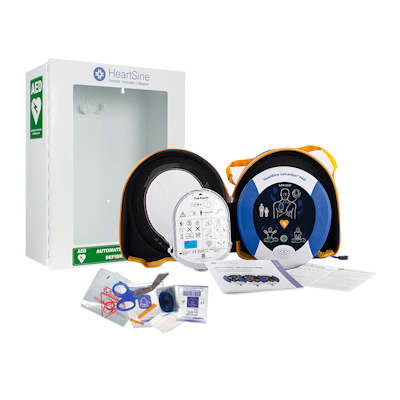
Defibrillator and cabinet starter kits are available and include everything you need to get your defibrillator in position and up and running.
Related posts
Reviewed: 17/06/2021 (doc:560 V1.0). Our articles are reviewed regularly. However, any changes made to standards or legislation following the review date will not have been considered. Please note that we provide abridged, easy-to-understand guidance. To make detailed decisions about your fire safety provisions, you might require further advice or need to consult the full standards and legislation.



























